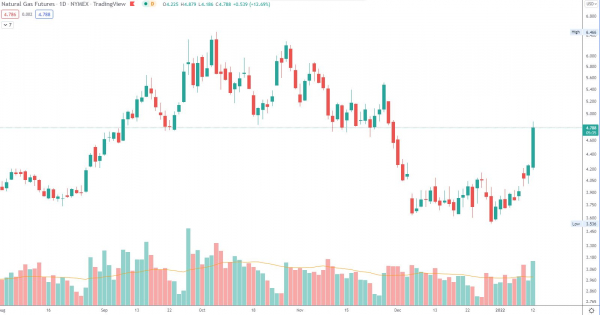Good evening, folks! Happy Hump day. 🐪
Stocks edged higher, but not by much. The U.S. consumer price index soared 7% YoY in December, marking the largest increase since 1982. 😳 More on this below.
The Nasdaq Composite rose for a third straight day, gaining 0.23%. The S&P 500 spiked 0.28%, but the Russell dropped 0.82%.
Natural gas futures flew 14% on Wednesday as temperatures dropped and predictions called for more winter weather. Read more in the bullets. ☃️ Here’s the daily chart:

Permian Basin Royalty Trust is rocking it in 2022. 🤘 $PBT is up 41.6% already and has registered 6 green days.
All but one sector closed in positive territory. 🍀 Materials marched 1% and is less than half a percent from all-time highs. Healthcare was the only sector to trade lower.
Ethereum jumped over 4% and defended the $3K level, topping bitcoin’s 2.5% return.
$AMR ascended 7.3%, $ENJ.X expanded 9%, and $ONE.X appreciated 13.5%.
The Here are the closing prices:
| S&P 500 | 4,726 | +0.28% |
| Nasdaq | 15,188 | +0.23% |
| Russell 2000 | 2,176 | -0.82% |
| Dow Jones | 36,290 | +0.11% |
Economy
Inflation Nation
The Labor Department reported December’s consumer price index today — and it wasn’t pretty. Inflation was up 7% YoY in December. The last time the CPI rose that quickly was 40 years ago, in 1982.
The consumer-price-index (CPI) measures how much Americans pay for goods and services. In November, the CPI was up 6.8% YoY, so the December report represents a 0.2% month-over-month increase in inflation. Similarly, the core price index (basically the CPI, just excluding food and energy categories) saw a 5.5% YoY increase in December. Economists are in agreement that the inflation hike is probably the consequence of labor and supply shortages, the high price of energy products, increased cash flow from Congress/the Fed, and Omicron (of course)… ugh.
Mike Loewengart, a director for E-trade investment strategy, shared “This morning’s CPI read really only solidifies what we already know: Consumer wallets are feeling pricing pressures and in turn the Fed has signaled a more hawkish approach. But the question remains if the Fed will pick up the pace given inflation is seemingly here to stay, at least in the medium-term.”
In 1980, inflation reached a peak of 14.8% under Jimmy Carter’s presidency. Like today, the Fed Chair in the early 80s, Paul Volcker, made it his mission to squash inflation. Volcker raised interest rates to 19% in 1981, prompting a recession — however, in 1982, both interest rates and inflation began to fall dramatically. Volcker is still remembered as somewhat of a legend who killed double-digit inflation. 🔪 📉
The prices of cars/trucks surged 37.3% in December, furniture prices hiked 17.3%, and 49% of small businesses surveyed in December will increase prices of goods/services in 2022. So is there any good news…?
Some economists (and the Fed!) anticipate that inflation will slow down in 2022 as supply/labor shortages are resolved. Hopefully Omicron doesn’t thwart our progress. 🤞
Sponsored
Ditch the Resolutions for the Distributions
It’s 2022 – time to ditch the outdated investment strategies of the past. Yieldstreet allows you to invest beyond the stock market with a marketplace of alternative investments. Invest in real estate, art, venture capital, and more. Discover why 350k+ members have invested over $2B with Yieldstreet.
Speaking of Omicron, Daily Rip readers know we hate to address Covid-19, the “elephant-in-the-room-turned-two-year-long-buzzkill.” 👎 🐘 However, given recent Covid-related antics, we feel like now is as good a time as any to call “peak Covid.”
The United States’ 7-day average for new Covid-19 cases is now over 750,000. In spite of that, the economy couldn’t be stronger. Sure, inflation is besting 7%, but there are now reportedly 12 million jobs available — and the unemployment rate is getting close to Trump-era lows. The Fed feels so strongly about its strides toward “maximum employment” and strong macro fundamentals that it’s preparing to hike rates earlier (mostly to arrest the inflation problem.) 📈
It’s funny to remember the government paying thousands of dollars to Americans — in the form of stimulus checks — to stay home when case numbers crept into five-figures. Now, at nearly seven-figure daily case counts, the government has pulled the plug on stimulus, encouraging Americans to return to work and maintain some form of psuedo-normalcy. But that won’t come without consequences: a record-high number of people are hospitalized because of Covid, and the number of ICU cases is also increasing.
Despite this, travel and leisure businesses are heading back to normalcy, and some states are leaning towards “business as usual.” ✈️ You might have a different opinion about whether that’s good or bad, but the ultimate takeaway is that Covid-19 is speed-running its way through America to infect millions.
Omicron might bring an end to the pandemic, but not without profound costs.
Company News
Microsoft Looks to Mimick Apple’s Chip Success
In 2020, Apple debuted its first proprietary chip, the M1 chip. The ARM-based M1 chip was seen to be a strong competitor to chips made by competitors such as AMD and Intel. In more recent iterations, the M1 class of chips have grown to great fanfare, giving Macs a real strong edge in the high-end computing space (especially in benchmarks.)
Microsoft took note. Now they want that sweet, sweet proprietary performance for themselves. According to The Verge, the tech giant is reportedly developing a new chip based on ARM tech, specifically for servers and their Surface PC line. To elevate their chances of success, Microsoft shamelessly hired one of Apple’s key engineers, Mike Filippo, to head up the custom chip effort.
In 2019, the company worked with AMD and Qualcomm on custom chips for its Surface Laptop 3 and Surface Pro X devices. Those partnerships have progressed through 2020, but might come to a conclusion if Microsoft develops its own in-house chip.
Ultimately, this pivot has strong echoes of Apple’s decision to part ways with Intel. And just like in the Apple case, Microsoft will be shading Intel in particular, who has historically benefited from their stronghold in both Mac and PC. However, big tech giants have newfound competition in each other, especially at the rate that they are pivoting to in-house ARM-based processors.
Google is developing its own ARM-based SoC for Chromebook, Amazon already has an ARM-based processor for its AWS server biz, Apple is mopping the floor with the M1 chipset, and it’s only fair that Microsoft has their own new playtoy. How that will fare for existing chip giants is untold. However, what is known is that companies like Taiwan Semiconductor, Samsung, and NVIDIA (who will own ARM once their merger clears antitrust hurdles) will stand to benefit from the push.
Company News
Justworks Punts IPO Due to Muddy Markets
Last week, we reported that Justworks filed for an IPO that could value the HR, payroll, and management company at $2 billion. 💰 However, the company has decided to delay its market debut, citing a less-than-ideal investment climate in public markets.
2020 was a marquee year for IPOs despite the pandemic. 159 IPOs raised over $67 billion in proceeds, and 242 SPACs raised $81 billion. While IPOs fared better than SPACs, late 2020 and early 2021 were especially fruitful for most growth names. 🍎 🤑 That all changed in mid-2021, given concerns about the Fed’s outlook.
Justworks’ decision to punt its IPO might be the most memorable walkback in recent memory, but it probably won’t be the last. The company’s decision indicates that there’s little appetite among large corporations for public markets, especially considering the uncertainty about the market’s performance this year amidst the Fed’s latest campaign. In other words, they’d rather play it safe than sorry.🤷
While Justworks decides to sit out a debut, investors will get to see how an IPO stands up in the current environment when private equity company TPG goes public on Thursday. The company reported that it would price its IPO at the midrange after the market closed today. ☀️
Bullets
Bullets from the Day
U.S. natural gas futures soared 14% in trading today. The price surge comes as colder temperatures seize hold of the eastern third of the U.S. One OTC analyst shared “Due to the cold weather, and realistic worries about tighter supply, prices are moving higher across the North American complex.” Read more in CNBC.
Cryptocurrencies thrive in Turkey as the Lira remains volatile. The Turkish Lira has plunged 40% against the dollar in the last year. Consequently, Turkey’s investors have opted for cryptocurrencies — during Q4 2021, crypto investments with the Turkish Lira increased by $1.8 billion on three major exchanges. Tether, the crypto pegged to the U.S. dollar, is especially popular in Turkey. Read more in WSJ.
Eyes on TSMC. Two days ago, Taiwan Semiconductor, or TSMC for short, reported that it notched a sixth consecutive quarter of record sales. The world’s 11th largest company will formally report earnings tomorrow, providing a keystone indicator into the health and outlook of the world’s largest semi business. It’ll also offer some clues into how the rest of the sector might shape up in 2022.




